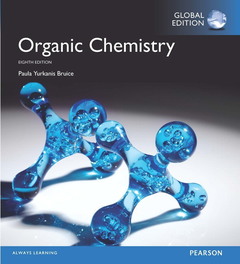Study Guide and Solutions Manual for Organic Chemistry, Global Edition (8th Ed.)
Auteur : Bruice Paula

- PART ONE: An Introduction to the Study of Organic Chemistry
- 1. Remembering General Chemistry: Electronic Structure and Bonding
- 2. Acids and Bases: Central to Understanding Organic Chemistry
- TUTORIAL: Acids and Bases
- 3. An Introduction to Organic Compounds: Nomenclature, Physical Properties, and Structure
- PART TWO: Electrophilic Addition Reactions, Stereochemistry, and Electron Delocalization
- TUTORIAL: Using Molecular Models
- 4. Isomers: The Arrangement of Atoms in Space
- TUTORIAL: Interconverting Structural Representations
- 5. Alkenes: Structure, Nomenclature, and an Introduction to Reactivity • Thermodynamics and Kinetics
- TUTORIAL: Drawing Curved Arrows
- 6. The Reactions of Alkenes • The Stereochemistry of Addition Reactions
- 7. The Reactions of Alkynes • An Introduction to Multistep Synthesis
- 8. Delocalized Electrons: Their Effect on Stability, pKa, and the Products of a Reaction • Aromaticity and Electronic Effects: An Introduction the Reactions of Benzene
- TUTORIAL: Drawing Resonance Contributors
- PART THREE: Substitution and Elimination Reactions
- 9. Substitution and Elimination Reactions of Alkyl Halides
- 10. Reactions of Alcohols, Ethers, Epoxides, Amines, and Sulfur-Containing Compounds
- 11. Organometallic Compounds
- 12. Radicals
- TUTORIAL: Drawing Curved Arrows in Radical Systems
- PART FOUR: Identification of Organic Compounds
- 13. Mass Spectrometry; Infrared Spectroscopy; and UV/Vis Spectroscopy
- 14. NMR Spectroscopy
- PART FIVE: Carbonyl Compounds
- 15. Reactions of Carboxylic Acids and Carboxylic Acid Derivatives
- 16. Reactions of Aldehydes and Ketones • More Reactions of Carboxylic Acid Derivatives
- 17. Reactions at the α-Carbon
- TUTORIAL: Synthesis and Retrosynthetic Analysis
- PART SIX: Aromatic Compounds
- 18. Reactions of Benzene And Substituted Benzenes
- 19. More About Amines • Reactions of Heterocyclic Compounds
- PART SEVEN: Bioorganic Compounds
- 20. The Organic Chemistry Of Carbohydrates
- 21. Amino Acids, Peptides, and Proteins
- 22. Catalysis in Organic Reactions and in Enzymatic Reactions
- 23. The Organic Chemistry of the Coenzymes, Compounds Derived from Vitamins
- 24. The Organic Chemistry of the Metabolic Pathways
- 25. The Organic Chemistry of Lipids
- 26. The Chemistry of the Nucleic Acids
- PART EIGHT: Special Topics in Organic Chemistry
- 27. Synthetic Polymers
- 28. Pericyclic Reactions
- Appendix I – pKa Values
- Appendix II – Kinetics
- Appendix III – Summary of Methods Used to Synthesize a Particular Functional Group
- Appendix IV – Summary of Methods Employed to Form Carbon-Carbon Bonds
- Appendix V – Spectroscopy Tables
- Appendix VI – Physical Properties of Organic Compounds
- Appendix VII – Answers to Selected Problems
A modern, streamlined organisation emphasises unifying principles of reactivity, offering an economy of presentation and discouraging memorisation
- The text consistently highlights the fundamental reason for all chemical reactions – electrophiles combine with nucleophiles — in order to keep students focused on the key ideas.
- Students are introduced to synthetic and retrosynthetic chemistry early on, allowing them to grasp multistep synthesis from the beginning.
The textbook bridges the gap between organic chemistry and biochemistry
Because bioorganic chemistry is the bridge between organic chemistry and biochemistry, the text emphasises that the organic reactions that chemists carry out in the laboratory are similar to those performed by nature inside a cell. These connections are especially important to biological science majors.
- In Chapters 1-20, the bioorganic material is presented as “interest boxes” and within the last sections of the chapters so that this material is available to the student without requiring the instructor to introduce bioorganic topics into the course.
- Chapters 21—26 focus on the organic chemistry of living systems. These chapters have the unique distinction of containing more chemistry than is typically found in the corresponding parts of a biochemistry text.
- Chapter 21 Amino Acids, Peptides, And Proteins
- Chapter 22 Catalysis In Organic Reactions And In Enzymatic
- Chapter 23 The Organic Mechanisms Of The Coenzymes, Compounds Derived From Vitamins
- Chapter 24 The Organic Chemistry Of The Metabolic Pathways
- Chapter 25 The Organic Chemistry Of Lipids
- Chapter 26 The Chemistry Of The Nucleic Acids
NEW! Improved visuals and orga
Date de parution : 07-2017
Ouvrage de 912 p.
21.6x27.4 cm
Disponible chez l'éditeur (délai d'approvisionnement : 12 jours).
Prix indicatif 72,61 €
Ajouter au panier


